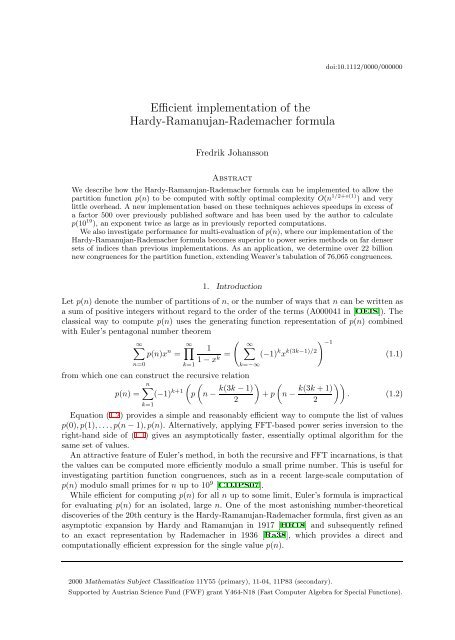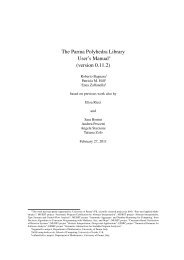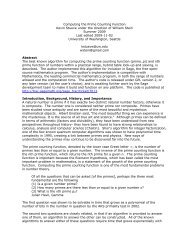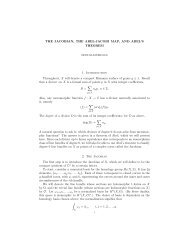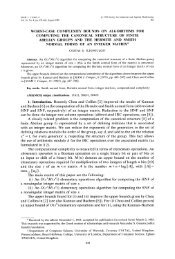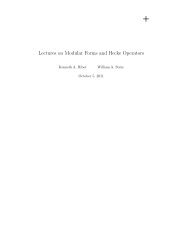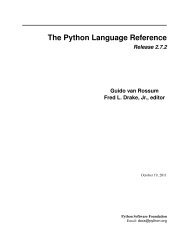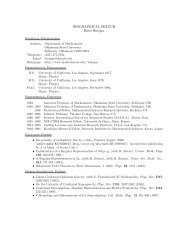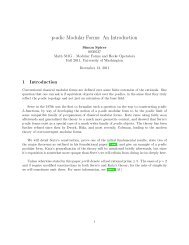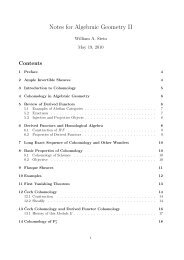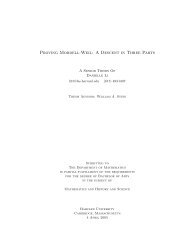Efficient implementation of the Hardy-Ramanujan ... - William Stein
Efficient implementation of the Hardy-Ramanujan ... - William Stein
Efficient implementation of the Hardy-Ramanujan ... - William Stein
Create successful ePaper yourself
Turn your PDF publications into a flip-book with our unique Google optimized e-Paper software.
doi:10.1112/0000/000000<br />
<strong>Efficient</strong> <strong>implementation</strong> <strong>of</strong> <strong>the</strong><br />
<strong>Hardy</strong>-<strong>Ramanujan</strong>-Rademacher formula<br />
Fredrik Johansson<br />
Abstract<br />
We describe how <strong>the</strong> <strong>Hardy</strong>-<strong>Ramanujan</strong>-Rademacher formula can be implemented to allow <strong>the</strong><br />
partition function p(n) to be computed with s<strong>of</strong>tly optimal complexity O(n 1/2+o(1) ) and very<br />
little overhead. A new <strong>implementation</strong> based on <strong>the</strong>se techniques achieves speedups in excess <strong>of</strong><br />
a factor 500 over previously published s<strong>of</strong>tware and has been used by <strong>the</strong> author to calculate<br />
p(10 19 ), an exponent twice as large as in previously reported computations.<br />
We also investigate performance for multi-evaluation <strong>of</strong> p(n), where our <strong>implementation</strong> <strong>of</strong> <strong>the</strong><br />
<strong>Hardy</strong>-<strong>Ramanujan</strong>-Rademacher formula becomes superior to power series methods on far denser<br />
sets <strong>of</strong> indices than previous <strong>implementation</strong>s. As an application, we determine over 22 billion<br />
newcongruences for <strong>the</strong> partition function, extendingWeaver’s tabulation <strong>of</strong> 76,065 congruences.<br />
n=0<br />
k=1<br />
1. Introduction<br />
Let p(n) denote <strong>the</strong> number <strong>of</strong> partitions <strong>of</strong> n, or <strong>the</strong> number <strong>of</strong> ways that n can be written as<br />
a sum <strong>of</strong> positive integers without regard to <strong>the</strong> order <strong>of</strong> <strong>the</strong> terms (A000041 in [OEIS]). The<br />
classical way to compute p(n) uses <strong>the</strong> generating function representation <strong>of</strong> p(n) combined<br />
with Euler’s pentagonal number <strong>the</strong>orem<br />
(<br />
∞∑ ∞∏ ∞<br />
) −1<br />
p(n)x n 1<br />
=<br />
1−x k = ∑<br />
(−1) k x k(3k−1)/2 (1.1)<br />
k=1<br />
k=−∞<br />
from which one can construct <strong>the</strong> recursive relation<br />
n∑<br />
(<br />
p(n) = (−1)<br />
(p<br />
k+1 k(3k −1)<br />
n−<br />
2<br />
) (<br />
+p n−<br />
))<br />
k(3k +1)<br />
. (1.2)<br />
2<br />
Equation (1.2) provides a simple and reasonably efficient way to compute <strong>the</strong> list <strong>of</strong> values<br />
p(0),p(1),...,p(n−1),p(n). Alternatively, applying FFT-based power series inversion to <strong>the</strong><br />
right-hand side <strong>of</strong> (1.1) gives an asymptotically faster, essentially optimal algorithm for <strong>the</strong><br />
same set <strong>of</strong> values.<br />
An attractive feature <strong>of</strong> Euler’s method, in both <strong>the</strong> recursive and FFT incarnations, is that<br />
<strong>the</strong> values can be computed more efficiently modulo a small prime number. This is useful for<br />
investigating partition function congruences, such as in a recent large-scale computation <strong>of</strong><br />
p(n) modulo small primes for n up to 10 9 [CDJPS07].<br />
While efficient for computing p(n) for all n up to some limit, Euler’s formula is impractical<br />
for evaluating p(n) for an isolated, large n. One <strong>of</strong> <strong>the</strong> most astonishing number-<strong>the</strong>oretical<br />
discoveries <strong>of</strong> <strong>the</strong> 20th century is <strong>the</strong> <strong>Hardy</strong>-<strong>Ramanujan</strong>-Rademacher formula, first given as an<br />
asymptotic expansion by <strong>Hardy</strong> and <strong>Ramanujan</strong> in 1917 [HR18] and subsequently refined<br />
to an exact representation by Rademacher in 1936 [Ra38], which provides a direct and<br />
computationally efficient expression for <strong>the</strong> single value p(n).<br />
2000 Ma<strong>the</strong>matics Subject Classification 11Y55 (primary), 11-04, 11P83 (secondary).<br />
Supported by Austrian Science Fund (FWF) grant Y464-N18 (Fast Computer Algebra for Special Functions).
Page 2 <strong>of</strong> 19<br />
FREDRIK JOHANSSON<br />
Simplified to a first-order estimate, <strong>the</strong> <strong>Hardy</strong>-<strong>Ramanujan</strong>-Rademacher formula states that<br />
p(n) ∼ 1<br />
4n √ 3 eπ√ 2n/3 , (1.3)<br />
from which one ga<strong>the</strong>rs that p(n) is a number with roughly n 1/2 decimal digits. The full version<br />
can be stated as<br />
(√ )<br />
N∑<br />
( )<br />
3 4 C(n)<br />
p(n) = A k (n) U +R(n,N), (1.4)<br />
k 24n−1 k<br />
k=1<br />
U(x) = cosh(x)− sinh(x) , C(n) = π 24n−1, (1.5)<br />
x 6√<br />
k−1<br />
∑<br />
( [<br />
A k (n) = δ gcd(h,k),1 exp πi s(h,k)− 2hn ])<br />
(1.6)<br />
k<br />
h=0<br />
where s(h,k) is <strong>the</strong> Dedekind sum<br />
s(h,k) =<br />
k−1<br />
∑<br />
i=1<br />
( ⌊ ⌋<br />
i hi hi<br />
k k − − 1 )<br />
k 2<br />
and where <strong>the</strong> remainder satisfies |R(n,N)| < M(n,N) with<br />
M(n,N) = 44π2<br />
225 √ 3 N−1/2 + π√ ( ) 1/2<br />
2 N π 2n<br />
sinh(<br />
75 n−1 N√<br />
3<br />
)<br />
(1.7)<br />
. (1.8)<br />
It is easily shown that M(n,cn 1/2 ) ∼ n −1/4 for every positive c. Rademacher’s bound (1.8)<br />
<strong>the</strong>refore implies that O(n 1/2 ) terms in (1.4) suffice to compute p(n) exactly by forcing<br />
|R(n,N)| < 1/2 and rounding to <strong>the</strong> nearest integer. For example, we can take N = ⌈n 1/2 ⌉<br />
when n ≥ 65.<br />
In fact, it was pointed out by Odlyzko [Od95, Kn05] that <strong>the</strong> <strong>Hardy</strong>-<strong>Ramanujan</strong>-<br />
Rademacher formula “gives an algorithm for calculating p(n) that is close to optimal, since<br />
<strong>the</strong> number <strong>of</strong> bit operations is not much larger than <strong>the</strong> number <strong>of</strong> bits <strong>of</strong> p(n)”. In o<strong>the</strong>r<br />
words, <strong>the</strong> time complexity should not be much higher than <strong>the</strong> trivial lower bound Ω(n 1/2 )<br />
derived from (1.3) just for writing down <strong>the</strong> result. Odlyzko’s claim warrants some elaboration,<br />
since <strong>the</strong> <strong>Hardy</strong>-<strong>Ramanujan</strong>-Rademacher formula ostensibly is a triply nested sum containing<br />
O(n 3/2 ) inner terms.<br />
The computational utility <strong>of</strong> <strong>the</strong> <strong>Hardy</strong>-<strong>Ramanujan</strong>-Rademacher formula was, <strong>of</strong> course,<br />
realized long before <strong>the</strong> availability <strong>of</strong> electronic computers. For instance, Lehmer [Le36] used<br />
it to verify <strong>Ramanujan</strong>’s conjectures p(599) ≡ 0 mod 5 3 and p(721) ≡ 0 mod 11 2 . Implementations<br />
are now available in numerous ma<strong>the</strong>matical s<strong>of</strong>tware systems, including Pari/GP[Pari],<br />
Ma<strong>the</strong>matica [Wo11] and Sage [Sage]. However, apart from Odlyzko’s remark, we find few<br />
algorithmic accounts <strong>of</strong> <strong>the</strong> <strong>Hardy</strong>-<strong>Ramanujan</strong>-Rademacher formula in <strong>the</strong> literature, nor any<br />
investigation into <strong>the</strong> optimality <strong>of</strong> <strong>the</strong> available <strong>implementation</strong>s.<br />
The present paper describes a new C <strong>implementation</strong> <strong>of</strong> <strong>the</strong> <strong>Hardy</strong>-<strong>Ramanujan</strong>-Rademacher<br />
formula. The code is freely available as a component <strong>of</strong> <strong>the</strong> Fast Library for Number Theory<br />
(FLINT) [Ha10], released under <strong>the</strong> terms <strong>of</strong> <strong>the</strong> GNU General Public License. We show<br />
that <strong>the</strong> complexity for computing p(n) indeed can be bounded by O(n 1/2+o(1) ), and observe<br />
that our <strong>implementation</strong> comes close to being optimal in practice, improving on <strong>the</strong> speed <strong>of</strong><br />
previously published s<strong>of</strong>tware by more than two orders <strong>of</strong> magnitude.<br />
We benchmark <strong>the</strong> code by computing some extremely large isolated values <strong>of</strong> p(n). We also<br />
investigate efficiency compared to power series methods for evaluation <strong>of</strong> multiple values, and<br />
finally apply our <strong>implementation</strong> to <strong>the</strong> problem <strong>of</strong> computing congruences for p(n).
IMPLEMENTATION OF THE HRR FORMULA Page 3 <strong>of</strong> 19<br />
2. Simplification <strong>of</strong> exponential sums<br />
A naive <strong>implementation</strong> <strong>of</strong> formulas (1.4)–(1.7) requires O(n 3/2 ) integer operations to<br />
evaluate Dedekind sums, and O(n) numerical evaluations <strong>of</strong> complex exponentials (or cosines,<br />
since <strong>the</strong> imaginary parts ultimately cancel out). In <strong>the</strong> following section, we describe how <strong>the</strong><br />
number <strong>of</strong> integer operations and cosine evaluations can be reduced, for <strong>the</strong> moment ignoring<br />
numerical evaluation.<br />
A first improvement, used for instance in <strong>the</strong> Sage <strong>implementation</strong>, is to recognize that<br />
Dedekind sums can be evaluated in O(logk) steps using a GCD-style algorithm, as described<br />
by Apostol [Ap97], or with Knuth’s fraction-free algorithm [Kn77] which avoids <strong>the</strong> overhead<br />
<strong>of</strong> rational arithmetic. This reduces <strong>the</strong> total number <strong>of</strong> integer operations to O(nlogn), which<br />
is a dramatic improvement but still leaves <strong>the</strong> cost <strong>of</strong> computing p(n) quadratic in <strong>the</strong> size <strong>of</strong><br />
<strong>the</strong> final result.<br />
Fortunately, <strong>the</strong> A k (n) sums have additional structure as discussed in [Le37, Le38, RW41,<br />
Wh56, Ha70], allowing <strong>the</strong> computational complexity to be reduced. Since numerous implementers<br />
<strong>of</strong> <strong>the</strong> <strong>Hardy</strong>-<strong>Ramanujan</strong>-Rademacher formula until now appear to have overlooked<br />
<strong>the</strong>se results, it seems appropriate that we reproduce <strong>the</strong> main formulas and assess <strong>the</strong><br />
computational issues in more detail. We describe two concrete algorithms: one simple, and<br />
one asymptotically fast, <strong>the</strong> latter being implemented in FLINT.<br />
2.1. A simple algorithm<br />
Using properties <strong>of</strong> <strong>the</strong> Dedekind eta function, one can derive <strong>the</strong> formula (which Whiteman<br />
[Wh56] attributes to Selberg)<br />
( ) 1/2 k ∑<br />
( ) 6l+1<br />
A k (n) = (−1) l cos<br />
3<br />
6k π (2.1)<br />
(3l 2 +l)/2≡−n mod k<br />
in which <strong>the</strong> summation ranges over 0 ≤ l < 2k and only O(k 1/2 ) terms are nonzero. With a<br />
simple brute force search for solutions <strong>of</strong> <strong>the</strong> quadratic equation, this representation provides<br />
a way to compute A k (n) that is both simpler and more efficient than <strong>the</strong> usual definition (1.6).<br />
Although a brute force search requires O(k) loop iterations, <strong>the</strong> successive quadratic terms<br />
can be generated without multiplications or divisions using two coupled linear recurrences.<br />
This only costs a few processor cycles per loop iteration, which is a substantial improvement<br />
over computing Dedekind sums, and means that <strong>the</strong> cost up to fairly large k effectively will<br />
be dominated by evaluating O(k 1/2 ) cosines, adding up to O(n 3/4 ) function evaluations for<br />
computing p(n).<br />
A basic <strong>implementation</strong> <strong>of</strong> (2.1) is given as Algorithm 1. Various improvements are possible:<br />
a modification <strong>of</strong> <strong>the</strong> equation allows cutting <strong>the</strong> loop range in half when k is odd, and <strong>the</strong><br />
number <strong>of</strong> cosine evaluations can be reduced by counting <strong>the</strong> multiplicities <strong>of</strong> unique angles<br />
after reduction to [0,π/4), evaluating a weighted sum ∑ m i cos(θ i ) at <strong>the</strong> end – possibly using<br />
trigonometric addition <strong>the</strong>orems to exploit <strong>the</strong> fact that <strong>the</strong> differences θ i+1 −θ i between<br />
successive angles tend to repeat for many different i.<br />
2.2. A fast algorithm<br />
From Selberg’s formula (2.1), a still more efficient but considerably more complicated<br />
multiplicative decomposition <strong>of</strong> A k (n) can be obtained. The advantage <strong>of</strong> this representation<br />
is that it only contains O(logk) cosine factors, bringing <strong>the</strong> total number <strong>of</strong> cosine evaluations<br />
for p(n) down to O(n 1/2 logn). It also reveals exactly when A k (n) = 0 (which is about half <strong>the</strong><br />
time). We stress that <strong>the</strong>se results are not new; <strong>the</strong> formulas are given in full detail and with<br />
pro<strong>of</strong>s in [Wh56].
Page 4 <strong>of</strong> 19<br />
FREDRIK JOHANSSON<br />
Algorithm 1 Simple algorithm for evaluating A k (n)<br />
Input: Integers k,n ≥ 0<br />
Output: s = A k (n), where A k (n) is defined as in (1.6)<br />
if k ≤ 1 <strong>the</strong>n<br />
return k<br />
else if k = 2 <strong>the</strong>n<br />
return (−1) n<br />
end if<br />
(s,r,m) ← (0,2,(n mod k))<br />
for 0 ≤ l < 2k do<br />
if m = 0 <strong>the</strong>n<br />
s ← s+(−1) l cos(π(6l+1)/(6k))<br />
end if<br />
m ← m+r<br />
if m ≥ k <strong>the</strong>n m ← m−k {m ← m mod k}<br />
r ← r+3<br />
if r ≥ k <strong>the</strong>n r ← r−k {r ← r mod k}<br />
end for<br />
return s<br />
First consider <strong>the</strong> case when k is a power <strong>of</strong> a prime. Clearly A 1 (n) = 1 and A 2 (n) = (−1) n .<br />
O<strong>the</strong>rwise let k = p λ and v = 1−24n. Then, using <strong>the</strong> notation (a|m) for Jacobi symbols to<br />
avoid confusion with fractions, we have<br />
⎧<br />
⎪⎨ (−1) λ (−1|m 2 )k 1/2 sin(4πm 2 /8k) if p = 2<br />
A k (n) = 2(−1)<br />
⎪⎩<br />
λ+1 (m 3 |3)(k/3) 1/2 sin(4πm 3 /3k) if p = 3 (2.2)<br />
2(3|k)k 1/2 cos(4πm p /k) if p > 3<br />
where m 2 , m 3 and m p respectively are any solutions <strong>of</strong><br />
(3m 2 ) 2 ≡ v mod 8k (2.3)<br />
(8m 3 ) 2 ≡ v mod 3k (2.4)<br />
(24m p ) 2 ≡ v mod k (2.5)<br />
provided, when p > 3, that such an m p exists and that gcd(v,k) = 1. If, on <strong>the</strong> o<strong>the</strong>r hand,<br />
p > 3 and ei<strong>the</strong>r <strong>of</strong> <strong>the</strong>se two conditions do not hold, we have<br />
⎧<br />
⎪⎨ 0 if v is not a quadratic residue modulo k<br />
A k (n) = (3|k)k<br />
⎪⎩<br />
1/2 if v ≡ 0 mod p,λ = 0<br />
(2.6)<br />
0 if v ≡ 0 mod p,λ > 1.<br />
If k is not a prime power, assume that k = k 1 k 2 where gcd(k 1 ,k 2 ) = 1. Then we can factor<br />
A k (n) as A k (n) = A k1 (n 1 )A k2 (n 2 ), where n 1 ,n 2 are any solutions <strong>of</strong> <strong>the</strong> following equations.<br />
If k 1 = 2, <strong>the</strong>n<br />
{<br />
32n 2 ≡ 8n+1 mod k 2<br />
n 1 ≡ n−(k2 2 −1)/8 mod 2, (2.7)<br />
if k 1 = 4, <strong>the</strong>n<br />
{<br />
128n 2 ≡ 8n+5 mod k 2<br />
k 2 2 n 1 ≡ n−2−(k 2 2 −1)/8 mod 4, (2.8)
IMPLEMENTATION OF THE HRR FORMULA Page 5 <strong>of</strong> 19<br />
and if k 1 is odd or divisible by 8, <strong>the</strong>n<br />
{<br />
k 2 2d 2 en 1 ≡ d 2 en+(k 2 2 −1)/d 1 mod k 1<br />
k 2 1 d 1en 2 ≡ d 1 en+(k 2 1 −1)/d 2 mod k 2<br />
(2.9)<br />
where d 1 = gcd(24,k 1 ), d 2 = gcd(24,k 2 ), 24 = d 1 d 2 e.<br />
Here (k 2 −1)/d denotes an operation done on integers, ra<strong>the</strong>r than a modular division. All<br />
o<strong>the</strong>r solving steps in (2.2)–(2.9) amount to computing greatest common divisors, carrying<br />
out modular ring operations, finding modular inverses, and computing modular square roots.<br />
Repeated application <strong>of</strong> <strong>the</strong>se formulas results in Algorithm 2, where we omit <strong>the</strong> detailed<br />
arithmetic for brevity.<br />
Algorithm 2 Fast algorithm for evaluating A k (n)<br />
Input: Integers k ≥ 1, n ≥ 0<br />
Output: s = A k (n), where A k (n) is defined as in (1.6)<br />
Compute <strong>the</strong> prime factorization k = p λ1<br />
1 pλ2 2 ...pλj j<br />
s ← 1<br />
for 1 ≤ i ≤ j and while s ≠ 0 do<br />
if i < j <strong>the</strong>n<br />
(k 1 ,k 2 ) ← (p λi<br />
i ,k/pλi i )<br />
Compute n 1 ,n 2 by solving <strong>the</strong> respective case <strong>of</strong> (2.7)–(2.9)<br />
s ← s×A k1 (n 1 ) {Handle <strong>the</strong> prime power case using (2.2)–(2.6)}<br />
(k,n) ← (k 2 ,n 2 )<br />
else<br />
s ← s×A k (n) {Prime power case}<br />
end if<br />
end for<br />
return s<br />
2.3. Computational cost<br />
A precise complexity analysis <strong>of</strong> Algorithm 2 should take into account <strong>the</strong> cost <strong>of</strong> integer<br />
arithmetic.Multiplication,division,computation<strong>of</strong>modularinverses,greatestcommondivisors<br />
and Jacobi symbols <strong>of</strong> integers bounded in absolute value by O(k) can all be performed with<br />
bit complexity O(log 1+o(1) k).<br />
At first sight, integer factorization might seem to pose a problem. We can, however, factor<br />
all indices k summed over in (1.4) in O(n 1/2 log 1+o(1) n) bit operations. For example, using<br />
<strong>the</strong> sieve <strong>of</strong> Eratos<strong>the</strong>nes, we can precompute a list <strong>of</strong> length n 1/2 where entry k is <strong>the</strong> largest<br />
prime dividing k.<br />
A fixed index k is a product <strong>of</strong> at most O(logk) prime powers with exponents bounded<br />
by O(logk). For each prime power, we need O(1) operations with roughly <strong>the</strong> cost <strong>of</strong><br />
multiplication, and O(1) square roots, which are <strong>the</strong> most expensive operations.<br />
To compute square roots modulo p λ , we can use <strong>the</strong> Tonelli-Shanks algorithm [To91, Sh72]<br />
or Cipolla’s algorithm [Ci03] modulo p followed by Hensel lifting up to p λ . Assuming that<br />
we know a quadratic nonresidue modulo p, <strong>the</strong> Tonelli-Shanks algorithm requires O(log 3 k)<br />
multiplications in <strong>the</strong> worst case and O(log 2 k) multiplications on average, while Cipolla’s<br />
algorithm requires O(log 2 k) multiplications in <strong>the</strong> worst case [CP05]. This puts <strong>the</strong> bit<br />
complexity <strong>of</strong> factoring a single exponential sum A k (n) at O(log 3+o(1) k), and gives us <strong>the</strong><br />
following result:
Page 6 <strong>of</strong> 19<br />
FREDRIK JOHANSSON<br />
Theorem 1. Assume that we know a quadratic nonresidue modulo p for all primes p up to<br />
n 1/2 . Then we can factor all <strong>the</strong> A k (n) required for evaluating p(n) using O(n 1/2 log 3+o(1) n)<br />
bit operations.<br />
Unfortunately, no provably fast way to find a nonresidue modulo p is known, but an<br />
exhaustive search will finish in O(1) expected tries per p at a cost <strong>of</strong> O(log 1+o(1) p) each.<br />
If we do not believe in <strong>the</strong> odds, we can still replace <strong>the</strong> assumption in Theorem 1 by <strong>the</strong><br />
Extended Riemann Hypo<strong>the</strong>sis by which it is sufficient [An52] to test O(log 2 p) candidates<br />
per prime p, allowing us to construct a table <strong>of</strong> nonresidues up to <strong>the</strong> bound n 1/2 in time<br />
⎛ ⎞<br />
O⎝ 1<br />
n∑<br />
1/2<br />
log 3+o(1) k⎠ = O(n 1/2 log 2+o(1) n). (2.10)<br />
logn<br />
k=1<br />
For <strong>the</strong> purposes <strong>of</strong> evaluating p(n), <strong>the</strong>se remarks are purely <strong>of</strong> academic interest, since <strong>the</strong><br />
primes will be miniscule compared to any presumed counterexamples to ERH.<br />
2.4. Implementation notes<br />
As a matter <strong>of</strong> practical efficiency, <strong>the</strong> modular arithmetic should be done with as little<br />
overhead as possible. FLINT provides optimized routines for arithmetic with moduli smaller<br />
than 32or64bits (depending on<strong>the</strong> hardwarewordsize) whichareused throughout;including,<br />
among o<strong>the</strong>r things, a binary-style GCD algorithm, division and remainder using precomputed<br />
inverses, and supplementary code for operations on two-limb (64 or 128 bit) integers.<br />
We note that since A k (n) = A k (n+k), we can always reduce n modulo k, and perform<br />
all modular arithmetic with moduli up to some small multiple <strong>of</strong> k. In principle, <strong>the</strong><br />
<strong>implementation</strong> <strong>of</strong> <strong>the</strong> modular arithmetic in FLINT thus allows calculating p(n) up to<br />
approximately n = (2 64 ) 2 ≈ 10 38 on a 64-bit system, which roughly equals <strong>the</strong> limit on n<br />
imposed by <strong>the</strong> availability <strong>of</strong> addressable memory to store p(n).<br />
At present, our <strong>implementation</strong> <strong>of</strong> Algorithm 2 simply calls <strong>the</strong> FLINT routine for integer<br />
factorization repeatedly ra<strong>the</strong>r than sieving over <strong>the</strong> indices. Although convenient, this<br />
technically results in a higher total complexity than O(n 1/2+o(1) ). However, <strong>the</strong> code for<br />
factoring single-word integers, which uses various optimizations for small factors and Hart’s<br />
“One Line Factor” variant <strong>of</strong> Lehman’s method to find large factors [Ha11], is fast enough<br />
that integer factorization only accounts for a small fraction <strong>of</strong> <strong>the</strong> running time for any feasible<br />
n. If needed, full sieving could easily be added in <strong>the</strong> future.<br />
Likewise,<strong>the</strong> squarerootfunction in FLINT uses<strong>the</strong> Tonelli-Shanksalgorithmand generates<br />
anonresiduemoduloponeachcall.Thisissuboptimalin<strong>the</strong>orybutefficientenoughinpractice.<br />
3. Numerical evaluation<br />
We now turn to <strong>the</strong> problem <strong>of</strong> numerically evaluating (1.4)–(1.5) using arbitrary-precision<br />
arithmetic,givenaccesstoAlgorithm2forsymbolicallydecomposing<strong>the</strong>A k (n)sums.Although<br />
(1.8) bounds <strong>the</strong> truncation error in <strong>the</strong> <strong>Hardy</strong>-<strong>Ramanujan</strong>-Rademacher series, we must also<br />
account for <strong>the</strong> effects <strong>of</strong> having to work with finite-precision approximations <strong>of</strong> <strong>the</strong> terms.<br />
3.1. Floating-point precision<br />
We assume <strong>the</strong> use <strong>of</strong> variable-precision binary floating-point arithmetic (a simpler but less<br />
efficient alternative, avoiding <strong>the</strong> need for detailed manual error bounds, would be to use<br />
arbitrary-precisionintervalarithmetic). Basicnotionsabout floating-pointarithmetic anderror<br />
analysis can be found in [Hi02].
IMPLEMENTATION OF THE HRR FORMULA Page 7 <strong>of</strong> 19<br />
If <strong>the</strong> precision is r bits, we let ε = 2 −r denote <strong>the</strong> unit round<strong>of</strong>f. We use <strong>the</strong> symbol ˆx<br />
to signify a floating-point approximation <strong>of</strong> an exact quantity x, having some relative error<br />
δ = (ˆx−x)/x when x ≠ 0. If ˆx is obtained by rounding x to <strong>the</strong> nearest representable floatingpoint<br />
number (at most 0.5 ulp error) at precision r, we have |δ| ≤ ε. Except where o<strong>the</strong>rwise<br />
noted, we assume correct rounding to nearest.<br />
A simple strategy for computing p(n) is as follows. For a given n, we first determine an<br />
N such that |R(n,N)| < 0.25, for example using a linear search. A tight upper bound for<br />
log 2 M(n,N) can be computed easily using low-precision arithmetic. We <strong>the</strong>n approximate <strong>the</strong><br />
kth term t k using a working precision high enough to guarantee<br />
|ˆt k −t k | ≤ 0.125<br />
N , (3.1)<br />
andperform<strong>the</strong> outersummationsuch that<strong>the</strong> absoluteerror<strong>of</strong>eachadditionisbounded by<br />
0.125/N.This clearlyguarantees|ˆp(n)−p(n)| < 0.5,allowingus todetermine <strong>the</strong> correctvalue<br />
<strong>of</strong> p(n) by rounding to <strong>the</strong> nearest integer. We might, alternatively, carry out <strong>the</strong> additions<br />
exactly and save one bit <strong>of</strong> precision for <strong>the</strong> terms.<br />
In what follows, we derive a simple but essentially asymptotically tight expression for a<br />
working precision, varying with k, sufficiently high for (3.1) to hold. Using Algorithm 2, we<br />
write <strong>the</strong> term to be evaluated in terms <strong>of</strong> exact integer parameters α,β,a,b,p i ,q i as<br />
t k = α √ ( ) a C ∏ m ( )<br />
pi π<br />
√ U cos . (3.2)<br />
β b k q i<br />
Lemma 2. Letp ∈ Z,q ∈ N + andletr beaprecisioninbitswith 2 r > max(3q,64).Suppose<br />
that sin and cos can be evaluated on (0,π/4) with relative error at most 2ε for floating-point<br />
input, and suppose that π can be approximated with relative error at most ε. Then we can<br />
evaluate cos(pπ/q) with relative error less than 5.5ε.<br />
i=1<br />
Pro<strong>of</strong>.<br />
We first reduce p and q with exact integer operations so that 0 < 4p < q, giving an angle<br />
in <strong>the</strong> interval (0,π/4). Then we approximate x = pπ/q using three roundings, giving ˆx =<br />
x(1+δ x ) where |δ x | ≤ (1+ε) 3 −1. The assumption ε < 1/(3q) gives (q/(q −1))(1+δ x ) < 1<br />
and <strong>the</strong>refore also ˆx ∈ (0,π/4).<br />
Next, we evaluate f(ˆx) where f = ±cos or f = ±sin depending on <strong>the</strong> argument reduction.<br />
By Taylor’s <strong>the</strong>orem, we have f(ˆx) = f(x)(1+δ ′ x) where<br />
|δ ′ x | = |f(ˆx)−f(x)|<br />
f(x)<br />
= x|δ x||f ′ (ξ)|<br />
f(x)<br />
for some ξ between x and ˆx, giving |δ ′ x| ≤ ( 1 4 π√ 2)|δ x |. Finally, rounding results in<br />
ˆf(ˆx) = f(x)(1+δ) = f(x)(1+δ ′ x )(1+δ f)<br />
where |δ f | ≤ 2ε. The inequality ε < 1/64 gives |δ| < 5.5ε.<br />
To obtain a simple error bound for U(x) where x = C/k, we make <strong>the</strong> somewhat crude<br />
restriction that n > 2000. We also assume k < n 1/2 and x > 3, which are not restrictions: if N<br />
is chosen optimally using Rademacher’s remainder bound (1.8), <strong>the</strong> maximum k decreases and<br />
<strong>the</strong> minimum x increases with larger n. In particular, n > 2000 is sufficient with Rademacher’s<br />
bound (or any tighter bound for <strong>the</strong> remainder).<br />
We assume that C is precomputed; <strong>of</strong> course, this only needs to be done once during <strong>the</strong><br />
calculation <strong>of</strong> p(n), at a precision a few bits higher than that <strong>of</strong> <strong>the</strong> k = 1 term.<br />
(3.3)
Page 8 <strong>of</strong> 19<br />
FREDRIK JOHANSSON<br />
Lemma 3. Suppose n > 2000 and let r be a precision in bits such that 2 r ><br />
max(16n 1/2 ,2 10 ). Let x = C/k where C is defined as in (1.5) and where k is constrained such<br />
that k < n 1/2 and x > 3. Assume that Ĉ = C(n)(1+δ C) has been precomputed with |δ C | ≤ 2ε<br />
and that sinh and cosh can be evaluated with relative error at most 2ε for floating-point input.<br />
Then we can evaluate U(x) with relative error at most (9x+15)ε.<br />
Pro<strong>of</strong>. We first compute ˆx = x(1+δ x ) = (C/k)(1+δ C )(1+δ 0 ) where |δ 0 | ≤ ε. Next, we<br />
compute<br />
Û(ˆx) = U(ˆx)(1+δ U ) = U(x)(1+δ ′ x )(1+δ U) = U(x)(1+δ) (3.4)<br />
where we have to bound <strong>the</strong> error δ ′ x propagated in <strong>the</strong> composition as well as <strong>the</strong> rounding<br />
error δ U in <strong>the</strong> evaluation <strong>of</strong> U(ˆx). Using <strong>the</strong> inequality x|δ x | < 4xε < log2, we have<br />
|δ ′ x| ≤ x|δ x|U ′ (x+x|δ x |)<br />
U(x)<br />
≤ x|δ x|exp(x+x|δ x |)<br />
2U(x)<br />
≤ x|δ x|exp(x)<br />
U(x)<br />
Evaluating U(ˆx) using <strong>the</strong> obvious sequence <strong>of</strong> operations results in<br />
(<br />
∣ cosh(ˆx)(1+2δ 1 )− sinh(ˆx) )<br />
(1+2δ 2 )(1+δ 3 ) (1+δ 4 )−U(ˆx)<br />
ˆx<br />
∣<br />
|δ U | =<br />
U(ˆx)<br />
≤ 3x|δ x |. (3.5)<br />
where |δ i | ≤ ε and ˆx > z where z = 3(1−4ε). This expression is maximized by setting ˆx as<br />
small as possible and taking δ 1 = δ 4 = −δ 2 = −δ 3 = ε, which gives<br />
(3.6)<br />
|δ U | < cosh(z) sinh(z)<br />
ε(3+2ε)+<br />
U(z) zU(z) ε(2+ε−2ε2 ) < 5.5ε (3.7)<br />
Expanding (3.4) using (3.5) and (3.7) gives |δ| < ε(5.5+9x+56xε+33xε 2 ). Finally, we<br />
obtain 5.5+56xε+33xε 2 < 15 by a direct application <strong>of</strong> <strong>the</strong> assumptions.<br />
Put toge<strong>the</strong>r, assuming floating-point <strong>implementation</strong>s <strong>of</strong> standard transcendental functions<br />
with at most 1 ulp error (implying a relative error <strong>of</strong> at most 2ε), correctly rounded arithmetic<br />
and <strong>the</strong> constant π, we have:<br />
Theorem 4. Let n > 2000. For (3.1) to hold, it is sufficient to evaluate (3.2) using a<br />
precision <strong>of</strong> r = max(log 2 N +log 2 |t k |+log 2 (10x+7m+22)+3, 1 2 log 2n+5,11) bits.<br />
Pro<strong>of</strong>. We can satisfy <strong>the</strong> assumptions <strong>of</strong> lemmas 2 and 3. In particular, 3q ≤ 24k <<br />
24n 1/2 < 2 r . The top-levelarithmetic operationsin (3.2), including <strong>the</strong> squareroots,amountto<br />
a maximum <strong>of</strong> m+6 roundings. Lemmas 2 and 3 and elementary inequalities give <strong>the</strong> relative<br />
error bound<br />
|δ| < (1+ε) m+6 (1+5.5ε) m (1+(15+9x)ε)−1 (3.8)<br />
(<br />
< 1+ (m+6)ε )(<br />
1+ 5.5mε )<br />
(1+(15+9x)ε)−1 (3.9)<br />
1−(m+6)ε 1−5.5mε<br />
= 21ε+6.5mε−33mε2 −5.5m 2 ε 2 +9xε<br />
(1−5.5εm)(1−ε(m+6))<br />
(3.10)<br />
< (10x+7m+22)ε. (3.11)<br />
The result follows by taking logarithms in (3.1).
IMPLEMENTATION OF THE HRR FORMULA Page 9 <strong>of</strong> 19<br />
To make Theorem 4 effective, we can use m ≤ log 2 k and bound |t k | a priori using (1.8) with<br />
N = k, or simply inspect <strong>the</strong> parameters in (3.2) for a given term.<br />
Naturally, for n ≤ 2000, <strong>the</strong> same precision bound can be verified to be sufficient through<br />
direct computation. We can even reduce overhead for small n by using a tighter precision,<br />
say r = |t k |+O(1), up to some limit small enough to be tested exhaustively (perhaps much<br />
larger than 2000). The requirement that r > 1 2 log 2n+O(1) always holds in practice if we set<br />
a minimum precision; for n feasible on present hardware, it is sufficient to never drop below<br />
IEEE double (53-bit) precision.<br />
3.2. Computational cost<br />
We assume that r-bit floating-point numbers can be multiplied in time M(r) =<br />
O(rlog 1+o(1) r). It is well known (see [BZ11]) that <strong>the</strong> elementary functions exp, log, sin<br />
etc. can be evaluated in time O(M(r)logr) using methods based on <strong>the</strong> arithmetic-geometric<br />
mean (AGM). A popular alternativeis binarysplitting, which typically has cost O(M(r)log 2 r)<br />
but tends to be faster than <strong>the</strong> AGM in practice.<br />
The <strong>Hardy</strong>-<strong>Ramanujan</strong>-Rademacher formula contains O(n 1/2 ) terms, where <strong>the</strong> kth term<br />
needs to be evaluated to a precision <strong>of</strong> O(n 1/2 /k)+O(logn) bits and can be written as a<br />
product<strong>of</strong>O(logk)factors.Usinganycombination<strong>of</strong>O(M(r)log α r) algorithmsforelementary<br />
functions, <strong>the</strong> complexity <strong>of</strong> <strong>the</strong> numerical operations is<br />
⎛<br />
n∑<br />
1/2 ( )<br />
O⎝<br />
n<br />
1/2<br />
logk M<br />
k<br />
k=1<br />
log α n 1/2<br />
k<br />
⎞<br />
⎠ = O<br />
( )<br />
n 1/2 log α+3+o(1) n<br />
(3.12)<br />
which is nearly optimal in <strong>the</strong> size <strong>of</strong> <strong>the</strong> output. Combined with <strong>the</strong> cost <strong>of</strong> <strong>the</strong> factoring<br />
stage, <strong>the</strong> complexity for <strong>the</strong> computation <strong>of</strong> p(n) as a whole is <strong>the</strong>refore, when properly<br />
implemented, s<strong>of</strong>tly optimal at O(n 1/2+o(1) ). From (3.12) with <strong>the</strong> best known complexity<br />
bound for elementary functions, we obtain:<br />
Theorem 5. The value p(n) can be computed in time O(n 1/2 log 4+o(1) n) (with <strong>the</strong><br />
assumption in Theorem 1).<br />
A subtle but crucial detail in this analysis is that <strong>the</strong> additions in <strong>the</strong> main sum must be<br />
implemented in such a way that <strong>the</strong>y have cost O(n 1/2 /k) ra<strong>the</strong>r than O(n 1/2 ), since <strong>the</strong> latter<br />
would result in an O(n) total complexity. If <strong>the</strong> additions are performed in-place in memory,<br />
we can perform summations <strong>the</strong> natural way and rely on carry propagation terminating in an<br />
expected O(1) steps, but many<strong>implementation</strong>s<strong>of</strong>arbitrary-precisionfloating-pointarithmetic<br />
do not provide this optimization.<br />
One way to solve this problem is to add <strong>the</strong> terms in reverse order, using a precision that<br />
matches <strong>the</strong> magnitude <strong>of</strong> <strong>the</strong> partial sums. Or, if we add <strong>the</strong> terms in forward order, we can<br />
amortize <strong>the</strong> cost by keeping separate summation variables for <strong>the</strong> partial sums <strong>of</strong> terms not<br />
exceeding r 1 ,r 1 /2,r 1 /4,r 1 /8,... bits.<br />
3.3. Arithmetic <strong>implementation</strong><br />
FLINT uses <strong>the</strong> MPIR library, derived from GMP, for arbitrary-precision arithmetic, and<br />
<strong>the</strong> MPFR library on top <strong>of</strong> MPIR for asymptotically fast arbitrary-precision floating-point<br />
numbers and correctly rounded transcendental functions [MPIR, GMP, MPFR]. Thanks to<br />
<strong>the</strong> strong correctness guarantees <strong>of</strong> MPFR, it is relatively straightforward to write a provably<br />
correct <strong>implementation</strong> <strong>of</strong> <strong>the</strong> partition function using Theorem 4.
Page 10 <strong>of</strong> 19<br />
FREDRIK JOHANSSON<br />
Although <strong>the</strong> default functions provided by MPFR are quite fast, order-<strong>of</strong>-magnitude<br />
speedups were found possible with custom routines for parts <strong>of</strong> <strong>the</strong> numerical evaluation. An<br />
unfortunate consequence is that our <strong>implementation</strong> currently relies on routines that, although<br />
heuristically sound, have not yet been proved correct, and perhaps are more likely to contain<br />
<strong>implementation</strong> bugs than <strong>the</strong> well-tested standard functions in MPFR.<br />
All such heuristic parts <strong>of</strong> <strong>the</strong> code are, however, well isolated, and we expect that <strong>the</strong>y can<br />
be replaced with rigorous versions with equivalent or better performance in <strong>the</strong> future.<br />
3.4. Hardware arithmetic<br />
Inspired by <strong>the</strong> Sage <strong>implementation</strong>, our <strong>implementation</strong> switches to hardware (IEEE<br />
double) floating-point arithmetic to evaluate (3.2) when <strong>the</strong> precision bound falls below 53<br />
bits. This speeds up evaluation <strong>of</strong> <strong>the</strong> “long tail” <strong>of</strong> terms with very small magnitude.<br />
Using hardware arithmetic entails some risk. Although <strong>the</strong> IEEE floating-point standard<br />
implemented on all modern hardware guarantees 0.5 ulp error for arithmetic operations,<br />
accuracy may be lost, for example, if <strong>the</strong> compiler generates long-double instructions which<br />
trigger double rounding, or if <strong>the</strong> rounding mode <strong>of</strong> <strong>the</strong> processor has been changed.<br />
We need to be particularly concerned about <strong>the</strong> accuracy <strong>of</strong> transcendental functions.<br />
The hardware transcendental functions on <strong>the</strong> Intel Pentium processor and its descendants<br />
guarantee an error <strong>of</strong> at most 1 ulp when rounding to nearest [In95], as do <strong>the</strong> s<strong>of</strong>tware<br />
routines in <strong>the</strong> portable and widely used FDLIBM library [Sun]. Never<strong>the</strong>less, some systems<br />
may be equipped with poorer <strong>implementation</strong>s.<br />
Fortunately, <strong>the</strong> bound (1.8) and Theorem 4 are lax enough in practice that errors up<br />
to a few ulp can be tolerated, and we expect any reasonably implemented double-precision<br />
transcendental functions to be adequate. Most importantly, range reducing <strong>the</strong> arguments <strong>of</strong><br />
trigonometric functions to (0,π/4) avoids catastrophic error for large arguments which is a<br />
misfeature <strong>of</strong> some <strong>implementation</strong>s.<br />
Sage additionally uses quad-double and long-double arithmetic for terms with a precision up<br />
to roughly 100 bits. This optimization is not presently used in FLINT for portability reasons,<br />
and in any case would have a relatively small performance impact except perhaps for small n<br />
since our <strong>implementation</strong> requires substantially fewer transcendental function evaluations in<br />
<strong>the</strong> affected precision range than Sage does.<br />
3.5. High-precision evaluation <strong>of</strong> exponentials<br />
MPFR implements <strong>the</strong> exponential and hyperbolic functions using binary splitting at high<br />
precision, which is asymptotically fast up to logarithmic factors. We can, however, improve<br />
performance by not computing <strong>the</strong> hyperbolic functions in U(x) from scratch when k is<br />
small. Instead, we precompute exp(C) with <strong>the</strong> initial precision <strong>of</strong> C, and <strong>the</strong>n compute<br />
(cosh(C/k),sinh(C/k)) from (exp(C)) 1/k ; that is, by kth root extractions which have cost<br />
O((logk)M(r)). Using <strong>the</strong> builtin MPFR functions, root extraction was found experimentally<br />
to be faster than evaluating <strong>the</strong> exponential function up to approximately k = 35 over a large<br />
range <strong>of</strong> precisions.<br />
For extremely large n, we also speed up computation <strong>of</strong> <strong>the</strong> constant C by using binary<br />
splitting to compute π (adapting code written by H. Xue [GMP2]) instead <strong>of</strong> <strong>the</strong> default<br />
function in MPFR, which uses arithmetic-geometric mean iteration. As has been pointed out<br />
previously [Zi06], binary splitting is more than four times faster for computing π in practice,<br />
despite <strong>the</strong>oretically having a log factor worse complexity. When evaluating p(n) for multiple<br />
values <strong>of</strong> n, <strong>the</strong> value <strong>of</strong> π should <strong>of</strong> course be cached, which MPFR does automatically.
IMPLEMENTATION OF THE HRR FORMULA Page 11 <strong>of</strong> 19<br />
3.6. High-precision cosines<br />
The MPFR cosine and sine functions implement binary splitting, with similar asymptotics<br />
as <strong>the</strong> exponential function. At high precision, our <strong>implementation</strong> switches to custom code<br />
for evaluating α = cos(pπ/q) when q is not too large, taking advantage <strong>of</strong> <strong>the</strong> fact that α is an<br />
algebraic number. Our strategy consists <strong>of</strong> generating a polynomial P such that P(α) = 0 and<br />
solving this equation using Newton iteration, starting from a double precision approximation<br />
<strong>of</strong> <strong>the</strong> desired root. Using a precision that doubles with each step <strong>of</strong> <strong>the</strong> Newton iteration, <strong>the</strong><br />
complexity is O(deg(P)M(r)).<br />
Thenumberscos(pπ/q)arecomputedfromscratchasneeded:cachingvalueswithsmallpand<br />
q was found to provide a negligible speedup while needlessly increasing memory consumption<br />
and code complexity.<br />
Our <strong>implementation</strong> uses <strong>the</strong> minimal polynomial Φ n (x) <strong>of</strong> cos(2π/n), which has degree<br />
d = φ(n)/2forn ≥ 3[WZ93].Moreprecisely,weuse<strong>the</strong>scaledpolynomial2 d Φ(x) ∈ Z[x].This<br />
polynomial is looked up from a precomputed table when n is small, and o<strong>the</strong>rwise is generated<br />
using a balanced product tree, starting from floating-point approximations <strong>of</strong> <strong>the</strong> conjugate<br />
roots. As a side remark, this turned out to be around a thousand times faster than computing<br />
<strong>the</strong> minimal polynomial with <strong>the</strong> standard commands in ei<strong>the</strong>r Sage or Ma<strong>the</strong>matica.<br />
We sketch <strong>the</strong> procedure for high-precision evaluation <strong>of</strong> cos(pπ/q) as Algorithm 3, omitting<br />
variousspecialcasesand<strong>implementation</strong>details(forexample,our<strong>implementation</strong>performs<strong>the</strong><br />
polynomial multiplications over Z[x] by embedding <strong>the</strong> approximate coefficients as fixed-point<br />
numbers).<br />
Algorithm 3 High-precision numerical evaluation <strong>of</strong> cos(pπ/q)<br />
Input: Coprime integers p and q with q ≥ 3, and a precision r<br />
Output: An approximation <strong>of</strong> cos(pπ/q) accurate to r bits<br />
n ← (1+(p mod 2))q<br />
d ← φ(n)/2<br />
{Bound coefficients in 2 d∏ d<br />
⌈ (<br />
i=1 (x−α)}<br />
b ← ⌈log 2 d⌉+ log d<br />
) ⌉<br />
2 d/2<br />
{Use a balanced product tree and a precision <strong>of</strong> b+O(logd) bits}<br />
Φ ← 2 d∏ deg(Φ)≤d<br />
i=1,gcd(i,n)=1<br />
(x−cos(iπ/n)) {Use basecase algorithm for cos}<br />
{Round to an integer polynomial}<br />
Φ ← ∑ d<br />
⌋<br />
k=0⌊<br />
[x k ]Φ+ 1 2 x<br />
k<br />
Compute precisions r 0 = r+8,r 1 = r 0 /2+8,...,r j = r j−1 /2+8 < 50<br />
x ← cos(pπ/q) {To 50 bits, using basecase algorithm}<br />
for i ← j −1,j −2...0 do<br />
{Evaluate using <strong>the</strong> Horner scheme at r i +b bit precision}<br />
x ← x−Φ(x)/Φ ′ (x)<br />
end for<br />
return x<br />
We donotattempt toprovethat<strong>the</strong>internalprecisionmanagement<strong>of</strong>Algorithm3iscorrect.<br />
However, <strong>the</strong> polynomial generation can easily be tested up to an allowed bound for q, and<br />
<strong>the</strong> function can be tested to be correct for all pairs p,q at some fixed, high precision r. We<br />
may <strong>the</strong>n argue heuristically that <strong>the</strong> well-behavedness <strong>of</strong> <strong>the</strong> object function in <strong>the</strong> rootfinding<br />
stage combined with <strong>the</strong> highly conservative padding <strong>of</strong> <strong>the</strong> precision by several bits<br />
per iteration suffices to ensure full accuracy at <strong>the</strong> end <strong>of</strong> each step in <strong>the</strong> final loop, given an<br />
arbitrary r.
Page 12 <strong>of</strong> 19<br />
FREDRIK JOHANSSON<br />
A different way to generate Φ n (x) using Chebyshev polynomials is described in [WZ93].<br />
One can also use <strong>the</strong> squarefree part <strong>of</strong> an <strong>of</strong>fset Chebyshev polynomial<br />
P(x) =<br />
T 2q (x)−1<br />
gcd(T 2q (x)−1,T ′ 2q (x))<br />
directly, although this is somewhat less efficient than <strong>the</strong> minimal polynomial.<br />
Alternatively, since cos(pπ/q) is <strong>the</strong> real part <strong>of</strong> a root <strong>of</strong> unity, <strong>the</strong> polynomial x q −1 could<br />
be used. The use<strong>of</strong>complexarithmetic addsoverhead,but <strong>the</strong> method wouldbe faster forlarge<br />
q since x q can be computed in time O((logq)M(r)) using repeated squaring. We also note that<br />
<strong>the</strong> secant method could be used instead <strong>of</strong> <strong>the</strong> standard Newton iteration in Algorithm 3. This<br />
increases <strong>the</strong> number <strong>of</strong> iterations, but removes <strong>the</strong> derivative evaluation, possibly providing<br />
some speedup.<br />
In our <strong>implementation</strong>, Algorithm 3 was found to be faster than <strong>the</strong> MPFR trigonometric<br />
functions for q < 250 roughly when <strong>the</strong> precision exceeds 400+4q 2 bits. This estimate includes<br />
<strong>the</strong> cost <strong>of</strong> generating <strong>the</strong> minimal polynomial on <strong>the</strong> fly.<br />
3.7. The main algorithm<br />
Algorithm 4 outlines <strong>the</strong> main routine in FLINT with only minor simplifications. To avoid<br />
possible corner cases in <strong>the</strong> convergence <strong>of</strong> <strong>the</strong> HRR sum, and to avoid unnecessary overhead,<br />
values with n < 128 (exactly corresponding to p(n) < 2 32 ) are looked up from a table. We only<br />
use k, n, N in Theorem 4 in orderto make <strong>the</strong> precision decrease uniformly, allowingamortized<br />
summation to be implemented in a simple way.<br />
Algorithm 4 Main routine implementing <strong>the</strong> HRR formula<br />
Input: n ≥ 128<br />
Output: p(n)<br />
Determine N and initial precision r 1 using Theorem 4<br />
C ← π 6√ 24n−1 {At r1 +3 bits}<br />
u ← exp(C)<br />
s 1 ← s 2 ← 0<br />
for 1 ≤ k ≤ N do<br />
Write term k as (3.2) by calling Algorithm 2<br />
if A k (n) ≠ 0 <strong>the</strong>n<br />
Determine term precision r k for |t k | using Theorem 4<br />
{Use Algorithm 3 if q i < 250 and r k > 400+4q 2 }<br />
t ← (−1) s√ a/b ∏ cos(p i π/q i )<br />
t ← t×U(C/k) {Compute U from u 1/k if k < 35}<br />
{Amortized summation: r(s 2 ) denotes precision <strong>of</strong> <strong>the</strong> variable s 2 }<br />
s 2 ← s 2 +t<br />
if 2r k < r(s 2 ) <strong>the</strong>n<br />
s 1 ← s 1 +s 2 {Exactly or with precision exceeding r 1 }<br />
r(s 2 ) ← r k {Change precision}<br />
s 2 ← 0<br />
end if<br />
end if<br />
end for<br />
return ⌊s 1 +s 2 + 1 2 ⌋
IMPLEMENTATION OF THE HRR FORMULA Page 13 <strong>of</strong> 19<br />
Since our <strong>implementation</strong> presently relies on some numerical heuristics (and in any case,<br />
considering<strong>the</strong>intricacy<strong>of</strong><strong>the</strong>algorithm),carehasbeentakentotestitextensively.Alln ≤ 10 6<br />
have been checked explicitly, and a large number <strong>of</strong> isolated n ≫ 10 6 have been compared<br />
against known congruences and values computed with Sage and Ma<strong>the</strong>matica.<br />
As a strong robustness check, we observe experimentally that <strong>the</strong> numerical error in <strong>the</strong> final<br />
sumdecreaseswithlargern.Forexample,<strong>the</strong>errorisconsistentlysmallerthan10 −3 forn > 10 6<br />
and smaller than 10 −4 for n > 10 9 . This phenomenon reflects <strong>the</strong> fact that (1.8) overshoots<br />
<strong>the</strong> actual magnitude <strong>of</strong> <strong>the</strong> terms with large k, combined with <strong>the</strong> fact that rounding errors<br />
average out pseudorandomly ra<strong>the</strong>r than approaching worst-case bounds.<br />
4. Benchmarks<br />
Table 1 and Figure 1 compare performance <strong>of</strong> Ma<strong>the</strong>matica 7, Sage 4.7 and FLINT on a<br />
laptop with a Pentium T4400 2.2 GHz CPU and 3 GiB <strong>of</strong> RAM, running 64-bit Linux. To <strong>the</strong><br />
author’s knowledge, Ma<strong>the</strong>matica and Sage contain <strong>the</strong> fastest previously available partition<br />
function <strong>implementation</strong>s by far.<br />
The FLINT code was run with MPIR version 2.4.0 and MPFR version 3.0.1. Since Sage 4.7<br />
usesanolderversion<strong>of</strong>MPIRandMa<strong>the</strong>maticaisbasedonanolderversion<strong>of</strong>GMP,differences<br />
in performance <strong>of</strong> <strong>the</strong> underlying arithmetic slightly skew <strong>the</strong> comparison, but probably not<br />
by more than a factor two.<br />
The limited memory <strong>of</strong> <strong>the</strong> aforementioned laptop restricted <strong>the</strong> range <strong>of</strong> feasible n to<br />
approximately 10 16 . Using a system with an AMD Opteron 6174 processor and 256 GiB RAM<br />
allowed calculating p(10 17 ), p(10 18 ) and p(10 19 ) as well. The last computation took just less<br />
than 100 hours and used more than 150 GiB <strong>of</strong> memory, producing a result with over 11 billion<br />
bits. Some large values <strong>of</strong> p(n) are listed in Table 2.<br />
AscanbeseeninTable1andFigure1,<strong>the</strong>FLINT<strong>implementation</strong>exhibitsatimecomplexity<br />
only slightly higher than O(n 1/2 ), with a comparatively small constant factor. The Sage<br />
n Ma<strong>the</strong>matica 7 Sage 4.7 FLINT Initial<br />
10 4 69 ms 1 ms 0.20 ms<br />
10 5 250 ms 5.4 ms 0.80 ms<br />
10 6 590 ms 41 ms 2.74 ms<br />
10 7 2.4 s 0.38 s 0.010 s<br />
10 8 11 s 3.8 s 0.041 s<br />
10 9 67 s 42 s 0.21 s 43%<br />
10 10 340 s 0.88 s 53%<br />
10 11 2,116 s 5.1 s 48%<br />
10 12 10,660 s 20 s 49%<br />
10 13 88 s 48%<br />
10 14 448 s 47%<br />
10 15 2,024 s 39%<br />
10 16 6,941 s 45%<br />
10 17 27,196* s 33%<br />
10 18 87,223* s 38%<br />
10 19 350,172* s 39%<br />
Table 1. Timings for computing p(n) in Ma<strong>the</strong>matica 7, Sage 4.7 and FLINT up to<br />
n = 10 16 on <strong>the</strong> same system, as well as FLINT timings for n = 10 17 to 10 19 (*) done on<br />
different (slightly faster) hardware. Calculations running less than one second were repeated,<br />
allowing benefits from data caching. The rightmost column shows <strong>the</strong> amount <strong>of</strong> time in <strong>the</strong><br />
FLINT <strong>implementation</strong> spent computing <strong>the</strong> first term.
Page 14 <strong>of</strong> 19<br />
FREDRIK JOHANSSON<br />
Figure 1. CPU time t in seconds for computing p(n): FLINT (blue squares), Ma<strong>the</strong>matica 7<br />
(green circles), Sage 4.7 (red triangles). The dotted line shows t = 10 −6 n 1/2 , indicating <strong>the</strong><br />
slope <strong>of</strong> an idealized algorithm satisfying <strong>the</strong> trivial lower complexity bound Ω(n 1/2 ) (<strong>the</strong><br />
<strong>of</strong>fset 10 −6 is arbitrary).<br />
<strong>implementation</strong> is fairly efficient for small n but has a complexity closer to O(n), and is limited<br />
to arguments n < 2 32 ≈ 4×10 9 .<br />
The Ma<strong>the</strong>matica <strong>implementation</strong> appears to have complexity slightly higher than O(n 1/2 )<br />
as well, but consistently runs about 200–500 times slower than our <strong>implementation</strong>. Based on<br />
extrapolation,computingp(10 19 )wouldtakeseveralyears.Itisunclearwhe<strong>the</strong>rMa<strong>the</strong>maticais<br />
actually using a nearly-optimal algorithm or whe<strong>the</strong>r <strong>the</strong> slow growth is just <strong>the</strong> manifestation<br />
<strong>of</strong> various overheads dwarfing <strong>the</strong> true asymptotic behavior. The ratio compared to FLINT<br />
appears too large to be explained by differences in performance <strong>of</strong> <strong>the</strong> underlying arithmetic<br />
alone; for example, evaluating <strong>the</strong> first term in <strong>the</strong> series for p(10 10 ) to required precision in<br />
Ma<strong>the</strong>matica only takes about one second.<br />
We get one external benchmark from [BB10], where it is reported that R. Crandall<br />
computed p(10 9 ) in three secondsonalaptopin December 2008,“using<strong>the</strong> <strong>Hardy</strong>-<strong>Ramanujan</strong>-<br />
Rademacher ‘finite’ series for p(n) along with FFT methods”. Even accounting for possible<br />
hardwaredifferences, this appearsto be an order<strong>of</strong>magnitudeslowerthan our<strong>implementation</strong>.<br />
4.1. Optimality relative to <strong>the</strong> first term<br />
Table 1 includes time percentages spent on evaluating <strong>the</strong> first term, exp(C), in <strong>the</strong> FLINT<br />
<strong>implementation</strong>. We find that this step fairly consistently amounts to just a little less than half<br />
<strong>of</strong> <strong>the</strong> running time. Our <strong>implementation</strong> is <strong>the</strong>refore nearly optimal in a practical sense, since<br />
<strong>the</strong> first term in <strong>the</strong> <strong>Hardy</strong>-<strong>Ramanujan</strong>-Rademacher expansion hardly can be avoided and at<br />
most a factor two can be gained by improving <strong>the</strong> tail evaluation.<br />
Naturally, <strong>the</strong>re is some potential to implement a faster version <strong>of</strong> <strong>the</strong> exponential function<br />
than <strong>the</strong> one provided by MPFR, reducing <strong>the</strong> cost <strong>of</strong> <strong>the</strong> first term. Improvements on <strong>the</strong> level<br />
<strong>of</strong> bignum multiplication would, on <strong>the</strong> o<strong>the</strong>r hand, presumably have a comparatively uniform<br />
effect.<br />
By similar reasoning, at most a factor two can be gained through parallelization <strong>of</strong> our<br />
<strong>implementation</strong> by assigning terms in <strong>the</strong> <strong>Hardy</strong>-<strong>Ramanujan</strong>-Rademacher sum to separate<br />
threads. Fur<strong>the</strong>r speedup on a multicore system requires parallelized versions <strong>of</strong> lower level<br />
routines,suchas<strong>the</strong>exponentialfunctionorbignummultiplication.(Asimplisticmultithreaded
IMPLEMENTATION OF THE HRR FORMULA Page 15 <strong>of</strong> 19<br />
version <strong>of</strong> <strong>the</strong> FLINT partition function was tested for n up to 10 18 , giving nearly a tw<strong>of</strong>old<br />
speedup on two cores, but failed when computing 10 19 for reasons yet to be determined.)<br />
Fortunately, it is likely to be more interesting in practice to be able to evaluate p(n) for a<br />
range <strong>of</strong> large values than just for a single value, and this task naturally parallelizes well.<br />
5. Multi-evaluation and congruence generation<br />
One <strong>of</strong> <strong>the</strong> central problems concerning <strong>the</strong> partition function is <strong>the</strong> distribution <strong>of</strong> values<br />
<strong>of</strong> p(n) mod m. In 2000, Ono [On00] proved that for every prime m ≥ 5, <strong>the</strong>re exist infinitely<br />
many congruences <strong>of</strong> <strong>the</strong> type<br />
p(Ak +B) ≡ 0 mod m (5.1)<br />
where A,B are fixed and k rangesoverall nonnegativeintegers. Ono’spro<strong>of</strong>is nonconstructive,<br />
but Weaver [We01] subsequently gave an algorithm for finding congruences <strong>of</strong> this type when<br />
m ∈ {13,17,19,23,29,31}, and used <strong>the</strong> algorithm to compute 76,065 explicit congruences.<br />
Weaver’s congruences are specified by a tuple (m,l,ε) where l is a prime and ε ∈ {−1,0,1},<br />
where we unify <strong>the</strong> notation by writing (m,l,0) in place <strong>of</strong> Weaver’s (m,l). Such a tuple<br />
corresponds to a family <strong>of</strong> congruences <strong>of</strong> <strong>the</strong> form (5.1) with coefficients<br />
A = ml 4−|ε| (5.2)<br />
B = ml3−|ε| α+1<br />
24<br />
+ml 3−|ε| δ, (5.3)<br />
where α is <strong>the</strong> unique solution <strong>of</strong> ml 3−|ε| α ≡ −1 mod 24 with 1 ≤ α < 24, and where 0 ≤ δ < l<br />
is any solution <strong>of</strong><br />
{<br />
24δ ≢ −α mod l if ε = 0<br />
(5.4)<br />
(24δ +α | l) = ε if ε = ±1.<br />
The free choice <strong>of</strong> δ gives l−1 distinct congruences for a given tuple (m,l,ε) if ε = 0, and<br />
(l−1)/2 congruences if ε = ±1.<br />
Weaver’s test for congruence essentially amounts to a single evaluation <strong>of</strong> p(n) at a special<br />
point n. We give a compact statement <strong>of</strong> this procedure as Algorithm 5. To find new<br />
congruences, we simply perform a brute force search over a set <strong>of</strong> candidate primes l, calling<br />
Algorithm 5 repeatedly.<br />
n Decimal expansion Number <strong>of</strong> digits Terms Error<br />
10 12 6129000962...6867626906 1,113,996 264,526 2×10 −7<br />
10 13 5714414687...4630811575 3,522,791 787,010 3×10 −8<br />
10 14 2750960597...5564896497 11,140,072 2,350,465 −1×10 −8<br />
10 15 1365537729...3764670692 35,228,031 7,043,140 −3×10 −9<br />
10 16 9129131390...3100706231 111,400,846 21,166,305 −9×10 −10<br />
10 17 8291300791...3197824756 352,280,442 63,775,038 5×10 −10<br />
10 18 1478700310...1701612189 1,114,008,610 192,605,341 4×10 −10<br />
10 19 5646928403...3674631046 3,522,804,578 582,909,398 4×10 −11<br />
Table 2. Large values <strong>of</strong> p(n). The table also lists <strong>the</strong> number <strong>of</strong> terms N in <strong>the</strong><br />
<strong>Hardy</strong>-<strong>Ramanujan</strong>-Rademacher formula used by FLINT (<strong>the</strong>oretically bounding <strong>the</strong> error by<br />
0.25) and <strong>the</strong> difference between <strong>the</strong> floating-point sum and <strong>the</strong> rounded integer.
Page 16 <strong>of</strong> 19<br />
FREDRIK JOHANSSON<br />
Algorithm 5 Weaver’s congruence test<br />
Input: A pair <strong>of</strong> prime numbers 13 ≤ m ≤ 31 and l ≥ 5, m ≠ l<br />
Output: (m,l,ε) defining a congruence, and Not-a-congruence o<strong>the</strong>rwise<br />
δ m ← 24 −1 mod m {Reduced to 0 ≤ δ m < m}<br />
r m ← (−m) mod 24 {Reduced to 0 ≤ m < 24}<br />
v ← m−3<br />
2<br />
x ← p(δ ( m ) {We have x ≢ 0)<br />
mod m} )+δ m<br />
(<br />
rm(l 2 −1)<br />
24<br />
y ← p m<br />
f ← (3 | l) ((−1) v r m | l) {Jacobi symbols}<br />
t ← y +fxl v−1<br />
if t ≡ ω mod m where ω ∈ {−1,0,1} <strong>the</strong>n<br />
return (m,l,ω(3(−1) v | l))<br />
else<br />
return Not-a-congruence<br />
end if<br />
5.1. Comparison <strong>of</strong> algorithms for vector computation<br />
In addition to <strong>the</strong> <strong>Hardy</strong>-<strong>Ramanujan</strong>-Rademacher formula, <strong>the</strong> author has added code<br />
to FLINT for computing <strong>the</strong> vector <strong>of</strong> values p(0),p(1),...p(n) over Z and Z/mZ. The<br />
code is straightforward, simply calling <strong>the</strong> default FLINT routines for power series inversion<br />
over <strong>the</strong> respective coefficient rings, which in both cases invokes Newton iteration and FFT<br />
multiplication via Kronecker segmentation.<br />
A timing comparison between <strong>the</strong> various methods for vector computation is shown in<br />
Table 3. The power series method is clearly <strong>the</strong> best choice for computing all values up to<br />
n modulo a fixed prime, having a complexity <strong>of</strong> O(n 1+o(1) ). For computing <strong>the</strong> full integer<br />
values, <strong>the</strong> power series and HRR methods both have complexity O(n 3/2+o(1) ), with <strong>the</strong> power<br />
series method expectedly winning.<br />
Ignoring logarithmic factors, we can expect <strong>the</strong> HRR formula to be better than <strong>the</strong> power<br />
series for multi-evaluation <strong>of</strong> p(n) up to some bound n when n/c values are needed. The factor<br />
c ≈ 10 in <strong>the</strong> FLINT <strong>implementation</strong> is a remarkable improvement over c ≈ 1000 attainable<br />
with previous <strong>implementation</strong>s <strong>of</strong> <strong>the</strong> partition function. For evaluation mod m, <strong>the</strong> HRR<br />
formula is competitive when O(n 1/2 ) values are needed; in this case, <strong>the</strong> constant is highly<br />
sensitive to m.<br />
For <strong>the</strong> sparse subset <strong>of</strong> O(n 1/2 ) terms searched with Weaver’s algorithm, <strong>the</strong> HRR formula<br />
has <strong>the</strong> same complexity as <strong>the</strong> modular power series method, but as seen in Table 3 runs more<br />
n Series (Z/13Z) Series (Z) HRR (all) HRR (sparse)<br />
10 4 0.01 s 0.1 s 1.4 s 0.001 s<br />
10 5 0.13 s 4.1 s 41 s 0.008 s<br />
10 6 1.4 s 183 s 1430 s 0.08 s<br />
10 7 14 s 0.7 s<br />
10 8 173 s 8 s<br />
10 9 2507 s 85 s<br />
Table 3. Comparison <strong>of</strong> time needed to compute multiple values <strong>of</strong> p(n) up to <strong>the</strong> given<br />
bound, using power series inversion and <strong>the</strong> <strong>Hardy</strong>-<strong>Ramanujan</strong>-Rademacher formula. The<br />
rightmost column gives <strong>the</strong> time when only computing <strong>the</strong> subset <strong>of</strong> terms that are searched<br />
with Weaver’s algorithm in <strong>the</strong> m = 13 case.
IMPLEMENTATION OF THE HRR FORMULA Page 17 <strong>of</strong> 19<br />
than an order <strong>of</strong> magnitude faster. On top <strong>of</strong> this, it has <strong>the</strong> advantage <strong>of</strong> parallelizing trivially,<br />
being resumable from any point, and requiring very little memory (<strong>the</strong> power series evaluation<br />
mod m = 13 up to n = 10 9 required over 40 GiB memory, compared to a few megabytes with<br />
<strong>the</strong> HRR formula). Euler’s method is, <strong>of</strong> course, also resumable from an arbitrary point, but<br />
this requires computing and storing all previous values.<br />
We mention that <strong>the</strong> authors <strong>of</strong> [CDJPS07] use a parallel version <strong>of</strong> <strong>the</strong> recursive Euler<br />
method. This is not as efficient as power series inversion, but allows <strong>the</strong> computation to be<br />
split across multiple processors more easily.<br />
5.2. Results<br />
Weaver gives 167 tuples, or 76,065 congruences, containing all l up to approximately 1,000–<br />
3,000 (depending on m). This table was generated by computing all values <strong>of</strong> p(n) with n <<br />
7.5×10 6 using <strong>the</strong> recursive version <strong>of</strong> Euler’s pentagonal <strong>the</strong>orem. Computing Weaver’s table<br />
from scratch with FLINT, evaluating only <strong>the</strong> necessary n, takes just a few seconds. We are<br />
also able to numerically verify instances <strong>of</strong> all entries in Weaver’s table for small k.<br />
As a more substantial exercise, we extend Weaver’s table by determing all l up to 10 6 for<br />
each prime m. Statistics are listed in Table 4. The computation was performed by assigning<br />
subsets <strong>of</strong> <strong>the</strong> search space to separate processes, running on between 40 and 48 active cores<br />
for a period <strong>of</strong> four days, evaluating p(n) at 6(π(10 6 )−3) = 470,970 distinct n ranging up to<br />
2×10 13 .<br />
We find a total <strong>of</strong> 70,359 tuples, corresponding to slightly more than 2.2 × 10 10<br />
new congruences. To pick an arbitrary, concrete example, one “small” new congruence is<br />
(13,3797,−1) with δ = 2588, giving<br />
p(711647853449k+485138482133)≡ 0 mod 13<br />
which we easily evaluate for all k ≤ 100, providing a sanity check on <strong>the</strong> identity as well as <strong>the</strong><br />
partition function <strong>implementation</strong>. As a larger example, (29,999959,0) with δ = 999958 gives<br />
p(28995244292486005245947069k+28995221336976431135321047)≡ 0 mod 29<br />
which, despite our efforts, presently is out <strong>of</strong> reach for direct evaluation.<br />
Complete tables <strong>of</strong> (l,ε) for each m are available at:<br />
http://www.risc.jku.at/people/fjohanss/partitions/<br />
http://sage.math.washington.edu/home/fredrik/partitions/<br />
m (m,l,0) (m,l,+1) (m,l,−1) Congruences CPU Max n<br />
13 6,189 6,000 6,132 5,857,728,831 448 h 5.9×10 12<br />
17 4,611 4,611 4,615 4,443,031,844 391 h 4.9×10 12<br />
19 4,114 4,153 4,152 3,966,125,921 370 h 3.9×10 12<br />
23 3,354 3,342 3,461 3,241,703,585 125 h 9.5×10 11<br />
29 2,680 2,777 2,734 2,629,279,740 1,155 h 2.2×10 13<br />
31 2,428 2,484 2,522 2,336,738,093 972 h 2.1×10 13<br />
All 23,376 23,367 23,616 22,474,608,014 3,461 h<br />
Table 4. The number <strong>of</strong> tuples <strong>of</strong> <strong>the</strong> given type with l < 10 6 , <strong>the</strong> total number <strong>of</strong><br />
congruences defined by <strong>the</strong>se tuples, <strong>the</strong> total CPU time, and <strong>the</strong> approximate bound up to<br />
which p(n) was evaluated.
Page 18 <strong>of</strong> 19<br />
FREDRIK JOHANSSON<br />
6. Discussion<br />
Two obvious improvements to our <strong>implementation</strong> would be to develop a rigorous, and<br />
perhapsfaster,version<strong>of</strong>Algorithm3forcomputingcos(pπ/q)tohighprecision,andtodevelop<br />
fast multithreaded <strong>implementation</strong>s <strong>of</strong> transcendental functions to allow computing p(n) for<br />
much larger n. Curiously, a particularly simple AGM-type iteration is known for exp(π) (see<br />
[BB03]), and it is tempting to speculate whe<strong>the</strong>r a similar algorithm can be constructed for<br />
exp(π √ 24n−1), allowing faster evaluation <strong>of</strong> <strong>the</strong> first term.<br />
Some performance could also be gained with faster low-precision transcendental functions<br />
(up to a few thousand bits) and by using a better bound than (1.8) for <strong>the</strong> truncation error.<br />
The algorithms described in this paper can be adapted to evaluation <strong>of</strong> o<strong>the</strong>r HRR-type<br />
series, such as <strong>the</strong> number <strong>of</strong> partitions into distinct parts<br />
Q(n) = π2√ 2<br />
24<br />
∞∑<br />
(<br />
A 2k−1 (n)<br />
(1−2k) 2 0 F 1 2, (n+ 1 )<br />
24 )π2<br />
12(1−2k) 2 . (6.1)<br />
k=1<br />
Using asymptotically fast methods for numerical evaluation <strong>of</strong> hypergeometric functions, it<br />
should be possible to retain quasi-optimality.<br />
An interesting question arising in connection with <strong>the</strong> A k (n) sums is whe<strong>the</strong>r one can find<br />
nonresidues for all primes up to some bound more efficiently than in isolation, analogously<br />
with sieving to find prime factors.<br />
7. Acknowledgements<br />
The author thanks Silviu Radu for suggesting <strong>the</strong> application <strong>of</strong> extending Weaver’s table<br />
<strong>of</strong> congruences, and for explaining Weaver’s algorithm in detail.<br />
<strong>William</strong> Hart gavevaluable feedback on various issues, and generouslyprovided access to <strong>the</strong><br />
computer hardwareused for <strong>the</strong> large-scalecomputations reported in this paper. The hardware<br />
wasfunded by Hart’sEPSRCGrantEP/G004870/1(Algorithmsin AlgebraicNumber Theory)<br />
and hosted at <strong>the</strong> University <strong>of</strong> Warwick.<br />
References<br />
An52 N. Ankeny, The least quadratic non residue, Annals <strong>of</strong> Ma<strong>the</strong>matics Vol. 55 No. 1 (1952), pp 65–72.<br />
Ap97 T. Apostol, Modular functions and Dirichlet series in number <strong>the</strong>ory, Springer, New York, second edition<br />
(1997).<br />
BB03 J. Borwein and D. Bailey, Ma<strong>the</strong>matics by experiment: plausible reasoning in <strong>the</strong> 21st century, A K Peters,<br />
Wellesley, MA (2003), pp. 137.<br />
BB10 J. Borwein and P. Borwein, Experimental and computational ma<strong>the</strong>matics: selected writings, Perfectly<br />
Scientific Press, Portland, OR (2010) pp. 250.<br />
BZ11 R. Brent and P. Zimmermann, Modern Computer Arithmetic, Cambridge University Press, New York<br />
(2011).<br />
CDJPS07 N. Calkin, J. Davis, K. James, E. Perez and C. Swannack, Computing <strong>the</strong> integer partition function,<br />
Ma<strong>the</strong>matics <strong>of</strong> Computation, Vol. 76, No. 259 (2007) pp. 1619–1638.<br />
Ci03 M. Cipolla, Un metodo per la risoluzione della congruenza di secondo grado, Napoli Rend. 9 (1903),<br />
153–163.<br />
CP05 R. Crandall and C. Pomerance, Prime Numbers: A Computational Perspective, Springer, New York (2005),<br />
pp. 99–103.<br />
GMP GMP: The GNU Multiple Precision Arithmetic Library, http://gmplib.org/<br />
GMP2 Computing billions <strong>of</strong> π digits using GMP, http://gmplib.org/pi-with-gmp.html<br />
Ha10 W. Hart, Fast library for number <strong>the</strong>ory: an introduction, Ma<strong>the</strong>matical S<strong>of</strong>tware – ICMS 2010, Lecture<br />
Notes in Computer Science Vol. 6327 pp. 88–91, http://www.flintlib.org<br />
Ha11 W.Hart,Aonelinefactoringalgorithm,preprint(2011). http://selmer.warwick.ac.uk/onelinefactor.pdf<br />
HR18 G. H. <strong>Hardy</strong> and S. <strong>Ramanujan</strong>, Asymptotic formulae in combinatory analysis, Proceedings <strong>of</strong> <strong>the</strong> London<br />
Ma<strong>the</strong>matical Society, 17 (1918) pp. 75–115.
IMPLEMENTATION OF THE HRR FORMULA Page 19 <strong>of</strong> 19<br />
Ha70 P. Hagis, Jr., A root <strong>of</strong> unity occurring in partition <strong>the</strong>ory, Proceedings <strong>of</strong> <strong>the</strong> American Ma<strong>the</strong>matical<br />
Society, Vol. 26, No. 4 (1970) pp. 579–582.<br />
Hi02 N. Higham, Accuracy and stability <strong>of</strong> numerical algorithms, SIAM, Philadelphia, second edition (2002).<br />
In95 Intel Corporation, Pentium Processor Family Developer’s Manual. Volume 3: Architecture and Programming<br />
Manual (1995), www.intel.com/design/pentium/MANUALS/24143004.pdf<br />
Kn77 D. Knuth, Notes on generalized Dedekind sums, Acta Arithmetica, Vol. 33 (1977) pp. 297–325.<br />
Kn05 D. Knuth, The Art <strong>of</strong> Computer Programming, Volume 4, Fascicle 3: Generating All Combinations and<br />
Partitions, Addison-Wesley (2005).<br />
Le36 D. Lehmer, On a conjecture <strong>of</strong> <strong>Ramanujan</strong>, Journal <strong>of</strong> <strong>the</strong> London Ma<strong>the</strong>matical Society, 11 (1936), pp.<br />
114–118.<br />
Le37 D.Lehmer,On <strong>the</strong> <strong>Hardy</strong>-<strong>Ramanujan</strong> seriesfor<strong>the</strong> partition function, Journal <strong>of</strong><strong>the</strong> London Ma<strong>the</strong>matical<br />
Society, 3 (1937) pp. 171–176.<br />
Le38 D. Lehmer, On <strong>the</strong> series for <strong>the</strong> partition function, Transactions <strong>of</strong> <strong>the</strong> American Ma<strong>the</strong>matical Society<br />
Vol. 43, No. 2 (1938) pp. 271–295.<br />
MPIR MPIR: Multiple Precision Integers and Rationals, http://www.mpir.org<br />
MPFR A. Fousse, G. Hanrot, V. Lefèvre, P. Pélissier and P. Zimmermann, MPFR: A multiple-precision binary<br />
floating-point library with correct rounding, ACM Transactions on Ma<strong>the</strong>matical S<strong>of</strong>tware, Vol. 33, Issue<br />
2 (2007), http://www.mpfr.org/<br />
Od95 A. Odlyzko, Asymptotic enumeration methods, in Handbook <strong>of</strong> Combinatorics Vol. 2, R. Graham,<br />
M. Grötschel, L. Lovász (editors), Elsevier, The Ne<strong>the</strong>rlands (1995) pp. 1063–1229.<br />
http://www.dtc.umn.edu/~odlyzko/doc/asymptotic.enum.pdf<br />
OEIS OEIS Foundation Inc., The On-Line Encyclopedia <strong>of</strong> Integer Sequences (2011), http://oeis.org/A000041<br />
On00 K. Ono, The distribution <strong>of</strong> <strong>the</strong> partition function modulo m, Annals <strong>of</strong> Ma<strong>the</strong>matics 151 (2000), pp.<br />
293–307.<br />
Pari Pari/GP, Bordeaux, 2011, http://pari.math.u-bordeaux.fr/<br />
Ra38 H. Rademacher, On <strong>the</strong> partition function p(n), Proceedings <strong>of</strong> <strong>the</strong> London Ma<strong>the</strong>matical Society, 43<br />
(1938) pp. 241–254.<br />
RW41 H. Rademacher and A. Whiteman, Theorems on Dedekind sums, American Journal <strong>of</strong> Ma<strong>the</strong>matics, Vol.<br />
63, No. 2 (1941) pp. 377–407.<br />
Sage W. <strong>Stein</strong> et al., Sage: Open Source Ma<strong>the</strong>matics S<strong>of</strong>tware, http://www.sagemath.org<br />
Sh72 D. Shanks, Five number-<strong>the</strong>oretic algorithms, Proceedings <strong>of</strong> <strong>the</strong> Second Manitoba Conference on<br />
Numerical Ma<strong>the</strong>matics (1972). pp. 51–70. 1972.<br />
Sun Sun Microsystems Inc., FDLIBM Version 5.3, http://www.netlib.org/fdlibm/readme<br />
To91 A. Tonelli, Bemerkung über die Auflösung quadratischer Congruenzen, Göttinger Nachrichten (1891), pp.<br />
344–346.<br />
We01 R. Weaver, New congruences for <strong>the</strong> partition function, The <strong>Ramanujan</strong> Journal, 5 (2001), pp. 53–63.<br />
WZ93 W. Watkins and J. Zeitlin, The minimal polynomial <strong>of</strong> cos(2π/n), The American Ma<strong>the</strong>matical Monthly,<br />
Vol. 100, No. 5 (1993) pp. 471–474.<br />
Wh56 A. Whiteman, A sum connected with <strong>the</strong> series for <strong>the</strong> partition function, Pacific Journal <strong>of</strong> Ma<strong>the</strong>matics,<br />
Vol. 6, No. 1 (1956), 159–176.<br />
Wo11 Wolfram Research Inc., Some Notes On Internal Implementation, Ma<strong>the</strong>matica documentation center<br />
(2011), http://reference.wolfram.com/ma<strong>the</strong>matica/note/SomeNotesOnInternalImplementation.html<br />
Zi06 P. Zimmermann, The bit-burst algorithm, Slides presented at Computing by <strong>the</strong> Numbers: Algorithms,<br />
Precision, and Complexity, Berlin, 2006. http://www.loria.fr/~zimmerma/talks/arctan.pdf<br />
Fredrik Johansson<br />
Research Institute for Symbolic<br />
Computation<br />
Johannes Kepler University<br />
4040 Linz, Austria<br />
fredrik.johansson@risc.jku.at


